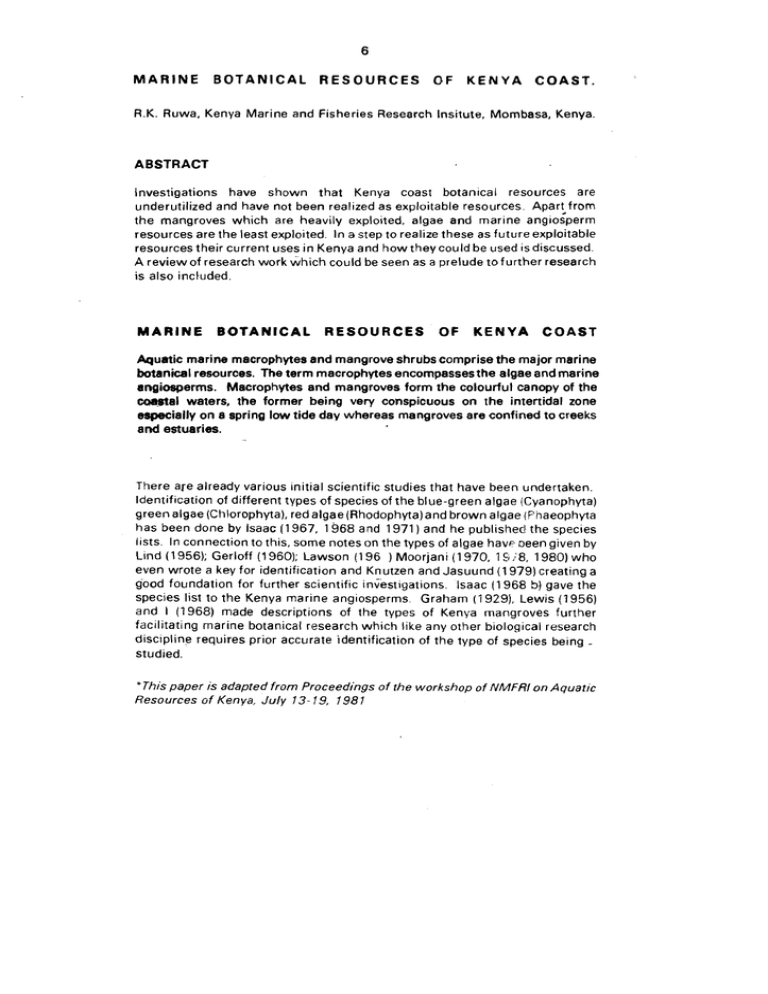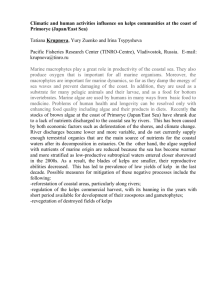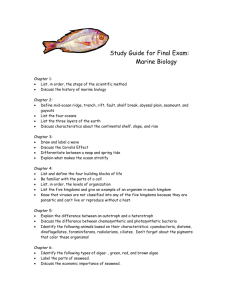M A R I N E B O... ABSTRACT
advertisement

MARINE BOTANICAL RESOURCES OF KENYA COAST. R.K. Ruwa, Kenya Marine and Fisheries Research Insitute, Mombasa, Kenya. ABSTRACT Investigations have shown that Kenya coast botanical resources are underutilized and have not been realized as exploitable resources. AparLfrom the mangroves which are heavily exploited, algae and marine angiosperm resources are the least exploited. I n a step to realize these as future exploitable resources their current uses i n Kenya and how they could be used isdiscussed. A review of research work which could be seen as a prelude to further research is also included. MARINE BOTANICAL RESOURCES OF KENYA COAST Aquatic marine macrophytes and mangrove shrubs comprise the major marine botanical resources. The term macrophytes encornpassesthe algae and marine angiosperms. Macrophytes and mangroves form the colourful canopy of the ~ - 8 t a waters, l the former being very conspicuous on the intertidal zone especially o n a spring low tide day whereas mangroves are confined t o creeks and estuaries. There are already various initial scientific studies that have been undertaken. Identification of different types of species of the blue-green algae (Cyanophyta) green algae (Chlorophyta), red algae (Rhodophyta)andbrown algae (Pnaeophyta has been done by lsaac (1967, 1 968 and 1971 ) and he published the species ~ given by lists. In connection to this, some notes on the types of algae h a v oeen Lind ( 1956); Gerloff (1960); Lawson ( 1 96 ) Moorjani ( 1 970, 1 S ;8, 1980) who even wrote a key for identification and Knutzen and Jasuund (1979)creating a gbod foundation for further scientific investigations. lsaac (1968 51 gave the species list to the Kenya marine angiosperms. Graham (19291, Lewis (1956) and 1 (1968) made descriptions of the types of Kenya mangroves further facilitating marine botanical research which like any other biological research discipline requires prior accurate identification of the type of species being studied. "This paper is adapted from Proceedings of the workshop of NMFRl on Aquatic Resources of Kenya, July 13- 19, 198 1 To date Kenya botanical studies have been qualitative. However, field observation have shown that t h e macrophytes show seasonal abundances 'related t o the northest (NE) and southeast (SE) monsoon (Isaac 1968, Moorjani 1 9 7 8 and 1979)due to t h e contrasting changes i n the climate, hydrography and tidal patterns during these seasons as documented by Newell (1957,1959) and Brakel(1980). The harvestable Rhodophyta whichdominate theflora i n number of species show t w o peaks both i n N.E and S.E monsoons: Phaeophyta are more abundant towards the end of t h e t h e SE monsoon period in September and October whereas Chlorophyta show m a i i m u m growth i n December/January during the NE monsoon and July/August during the SE monsoon. I n general, there is better algae growth and angiosperms during the SE monsoon (Isaac and lsaac 1968; Moorjani 1978, 1979). The reproduction biology of algae, some marine angiosperms and mangroves has been done. Moorjani (1969, 1978) discussed the fruiting phenology of the algae. Various reproductive structures of mangroves have been described by lsaac and lsaac (1968). Kay (1971) studied the floral structures of marine angiosperms Cynodocea serrulata and Thelessodendroin ciliatum (Cymodocee ciliata at M i d a creek. Some studies o n the flowering of other marine ang losperms Halophila stipulacea; Syri17godiumisoetifolium, Zostera capensis, Cymodocea serulata and Thalass~ahemprichii have been carried out under c o n t r o l l e d c o n d i t i o n s b y M c M i l l a n ( 1 9 8 0 a ) a n d ( 1 9 8 0 b). Botanical resources are broadly important i n t w o ways, namely ecologically and economically. The ecological importance of macrophytes and mangroves are as follows: They are the primary producers and produce the food which is t h e key maintenance of the ecosystem; 2. Offer shelter to many invertebrates, e.g., echinoderms; crustecea, molluscs, epiphytes etc; 3 . They are sediment binders and builders;. e.g., sand binder Rhizocl~nium spp, roots of various angiosperms, especially Thalassia and Cymodocea help t o hold soil particles together, creating suitable microhabitats for organisms that would be easily swept away by ctirrent; [mangrove roots help the accumulation of sediments which accommodate various detritivores which release various nutrients. No other botanical resource at t h e Kenya coast other than mangroves have been used as resources of acquiring income. Mangroves are used i n various ways notably as: 1. Poles which are used for building and even exported to other countries, e.g., i n the Middle East; 2. Charcoal; 3. Tannin used for treating leather, have formed a good trade. The marine angiosperm Enhalus acoroides which has long tough leaves and rhizomes found around Lamu is used in two ways: 1. Its leaves are used for weaving mats; 2. Its rhizomes are eaten notably by the Lamu people. Various typesof brown algae like Cytoseira spp. Turbinaria spp. and Sargassurn spp. red algae, e.g., Hypnea spp. and green algae, e.g., Ulva spp. are used as baits in traps to catch herbivorous fish at various parts of the Kenya coast. Indeed a comparison of the worldwide uses of the types of aquatic macrophytes also found i n Kenya (table 1) shows clearly how our resources have been underutilized. In Tanzania the brown algaeSargassum, Turbinaria and red algae Eucheuma, Hypnea and Glacilaria are being exploited and Eucheuma is actively picked, especially around Pemba,Zanzibar and Mafia (Matthes 1974). Different types of uses of aquatic macrophytes products have been documented by many authors and the following uses summarized from Dawnson (1966); Levrin, Hope and Schmid (1969) and Kumar and Singh (1971) Phaeophyta are the sources of alginic acid and alginates which are salts of the latter. The types of algae from which these are extracted and which are also found in Kenya shores are indicated in table 1. Alginic acid and alginates have been variously used in the following ways: 1. They are used in preparation of productsof human consumption, e.g., soup and antibiotic capsules among other things. 2. Alginates are used as thickeners i n cosmetic, textile and :~harmaceutical industries and as emulsfying agents i n preparation of polishes and paints. Rhodophyta are notably known algae source of agar extraction. Agar is used as: 1. A culture media for, among other things, bacteria and fungi i n various medical and institutional researches; 2. As stabilizers in food, cosmetics and leather The use of aquatic marine macrophytes for food and fertilizer is due t o t h e high valuable mineral elements they accumulate. Phaeophyta are rich sources of soda, potash, iodine and can yield a good amount of ammonia, tar and charcoal w h e n carefully processedRhodophyta yield more iodine t h a n any othertypes of algae. Iodine is used for treatment of goiter. Marine macrophytes are also rich in copper, iron, zinc, cobalt, vanadium, molybdenum, manganese, boron and chromium, which is all the more reason w h y they are used as fertilizers. Another reason why they are useful i n agriculture is that they increase t h e water holding capacity because t h e fragments of algae hold m u c h water providing valuable small reservoir of water i n close contact w i t h the roots of cultivated plants. Furthermore, t h e bulky organic substances decay slowly in t h e soil and form humus. Periodically, large masses of marine macrophytes are cast at various places of t h e Kenya coast shore and are not used, Indeed these could be used as fertilizers. W h y t h e macrophytes are not popular exploitable resources i n Kenya could be due to the facts that they: 1 . are not locally used for food; 2. have not been known to be fertilizers; 3. have not been considered as worthwhile mane;/ earning resource to support livelihood and probably that is w h y it has been overlooked to suggest collect~ng, process and export t o countries i n need of t h e macrophytes r a w materials or products. A t thisjuncture, needlessto further stress, even though there is little local use of marine macrophytes unlike t h e over exploited mangrove shrubs and whose importance for conservation and need for research has been discussed by one of the participants, Dr. W.H. Brakel, at this symposium, algae and marine angiosperms could be used i n t h e various ways stated. A small project could be carried out to show the importance of marine macrophytes casts as good fertilizers and secondly, ways in which they could be picked and marketed to utilizers w h o would buy at profitable prices and h o w this would create an interest into their exploitation. Whereas n o w w e are faced w i t h a n unrealized underexploited resource, whose importance has been overlooked, at this current pace of various identification for potential exploitable resources w i l l definitely be realized and used. Moreover, since meaningful exploitation inevitably requires scientific research, quantitative biomass assessment, mineral content composition and culturing need t o b e undertaken. Apart from lmbamba (1972) there have been no other studies on t h e mineral content o f t h e Kenya marine algae a further study which is n o w essential i n o r d e r t o identify the unique marine macrophytes that could be efficiently used as fertilizers or for various further uiseful extracts. Based on the various stated uses o f marine macrophytes, this n e w area of resources definitely calls for research. Table: 1 Various uses of the types of algae that are also found in Kenya intertidal zone. (Summarized from: Dawnson (1966); Levring, Hoppe and Schmid (1969). and Kumar and Singh (1971). ~p Utilization of product Place of production or Utilization 1. Caulerpa food Mediterranea countries, Asia 2. Chaetomorpha food Asia 3 . Enteromorpha salad and food for animals India Type of Algae A. Chlorophyta 6. Rhodophyta 1. Eucheuma Raw material of agar Japan 2 . Gelidium ,, World wide 3 . Gracilaria I ,, ,, ,, 4. Ceramium 5. Hypnea 88 Hypnean ,, ,, Eastern countries Subtropic and tropical couniries 6. Lithothamnion Powdered and used in place of lime in conditioning soil Asia C. Phaeophyta 1 . Cystoseira 2 . Sargassum alginic acid and alginates (a) Worldwide Alginic acid and Alginates (b) 3. Turbinaria Food (a) Alginic acid Asia Worldwide and alginates (b) Fertilizer for 4. Padina Phillipines and Coconut plantations India fertilizer Phillipines REFERENCES 1. Brakel, W.H. (1980). Tidal patterns o n the East Africa coast and their implications for littoral biota. Proceedings of UNESCO/ALESCO symposium o n the coastal and marine environment o n the Red Sea, Gulf of Aden, and Tropical Western Indian Ocean, Khartoum, Sudan. 2. Dawnson, Y.E (1966). Marine Botany. Holt, Rinchart and Winston, Inc. 371 pp. 3. Gerloff, J. ( 1960). Meeresalgen aus Kenya I. Cyanophyta Und Chlorophyta Willdenowia. 2:604 - 627 4. Graham, R.M. (1929). Notes on the mangrove swamps of Kenya. J. East Afr. Nat. Hisr. Soc. 36: 157 - 164 5, Imbamba, S.K. (1972). Mineral element content of some benthic marine algae of 'Kenya coast. Bot. Marine Volt. 15 : 113 115. - 6. Isaac, W.E. (1967). Marine Botany of the Kenya coast. I.A. first list of Kenya Marine Algae, J. East Afr. Nat. His. Soc. 2 6 : 7 5 - 81 7. Isaac, W.E. (1968 a). Marine Botany of the Kenya co,ast 2. A second list of Kenya Marine Algae. J. East Afr. Nat. Hist. Soc. 27 : 7 - 6. , 8. Isaac, W.E. and Isaac F.M. (1968). Marine Botany of Kenya coast 3. General account of environment flora and vegetation. J. East Afr. Nat. Hist. Soc. 27 (1) : 7 - 28. 9. Isaac, F.M. (1968 b). Marine Botany of the Kenya coast 4. Angiosperms. J. East Afr. Nat. Hist. Soc. 27 : 29-47 10.. Isaac, W.E. (1971). Marine Botany of the Kenya coast 5. A third list of Kenya Marine algae. J. East Afr, Nat. Hist. Soc. 28 (122) : 1 - 23. 11. Kay, Q.O.N. (1971). Floral structure in the marine angiosperms Cymodocea serrulata and Thalassodendron ciliaturn (Cyrnodocea cilata). Bot. J. Linn. Soc. 6 4 : 4 2 3 - 429. 12. Knutzen, J. and Jaasund E. (1979). Note on littoral algae from Mombasa K e n y a , J. E a s t A f r . N a t . H i s t . S o c . 1 6 8 : 1 - 4 13. Kumar, H.D. and Singh H.N. (1971). A text book on Algae London: Van Nostrand Reinbold Company, 2 0 0 pp. 14. Lawson, G.W. (1969). Some observations on the littoral ecology of rocky shores i n East Africa (Kenya and Tanzania). Trans. R.Soc. S . 4frica. 3 8 : 3 2 9 - 340. 15. Lewis J. (1956). Flora of tropical East Africa, Rhizophorr,=eae. Published under the authority of the Secretary of State for Colonies b y t h e Crown Agents for overseas Governments and Administrations London: Mulibank. 16. Levring, T., H.A. Hoppea and O.J. Schmud (1969). Marine Algae A survey of Research and Utilization Cram. Hamburg: D. Cruyter and Co. 42 1 pp. 17. Lind, E.M. (1956). Some notes o n marine algae of the Kenya Coast. Phyc. no. 4 : 2 5 - 2 6 Bull. (of Br. Phycological Soc.). Matthes, H. (1974). Coastal and estruarine aquaculture: In International Conference on Marine Resources Development in Eastern Africa edited by Msangi, A.S. and J.J.Griffin. Dar-es-salaam, Tanzania: University of Dares-Salaam. McMillan, C. (1980 a). Flowering under controlled conditions by Cyrnoclocea sernulata, Halophila stipulacea, Syringdium isoefifolium, Zostera capensis and Thalassia hemprichiifrom Kenya. Aquatic Bot. 8 (4) : 323 - 336 McMillan, C. (1980b). Stum.inate flowers under controlled conditions by Cymodecea serrulata from Kenya. Aquat. Bof. 9 : 291 - 295. Moorjani, S.A. (1969). A note o n the possible reproductive structures in Kenya Udotea orientalis A a n d E.S. Gepp. (Chlorophyta) .. J. East Afri. Nat. Hist. Sac. 2 7 no.1 (1 18) : 227 - 227. Moorjani, S.A. (1970). Notes on Kenya Acetabularia Lemourove, (Chlorophyta). J. East Afri. Nat. Hist, Soc. 2 8 no.1 (1 19). : 4 7 - 52. Moorjani. S.A. (1978. The ecology of marine algae of the Kenya coast. Ph.D. ~ h e & s University , of Nairobi. Moorjani. S.A. (1979). Seasonal changes i m the marine algae of the Kenya coast. Paper presented at the international symposium o n marine algaeof the Indian Ocean region, Bhaunagar, India. Moorjani, S.A. (1980). Rocky shore zonation i n Kenya, Horizontal and vertical distribution patterns in marine flora. Proceedings of UNESCO ALESCO symposium on the coastal and marine environment of the REd Sea, Gulf of Aden an8 tropical western Indian Ocean, Khartoum. Sudan. Newell, B.S. (1957). A preliminary survey of the hydrography of the British East A f r i c a Coastal w a t e r s . Col. O f f . F i s h P u b l . no. 9. Newell, B.S. (1959). Hydrography of the British East African Coastal waters, Part 11. Col. Off. Fish Publ. no. 12.







